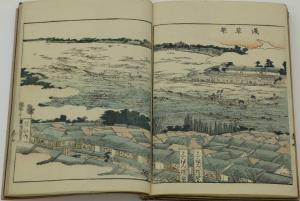Asakusa Festival from "Picture Book: Amusements of Edo" (Ehon Azuma Asobi Asakusa Matsuri)
Painted by Katsushika Hokusai 1802 (Kyōwa 2) Tokyo Shiryō Collection 025-25
Nowadays, Sanja Festival of Asakusa Shrine (Asakusa Festival) is held in May, but in the Edo period, it was held on both the 17th and 18th of the third month and the main festival was held every alternate year on the years of the ox, rabbit, snake, sheep, cock and wild boar.
The Asakusa Shrine is also known as 'Sanjasama, three shrines,' from the fact that three gods are worshiped here. Because of this, the festival also became generally known as the Sanja Festival and in the Edo period, the portable shrine was laid outside the Kannon Temple making it a festival where Senso-ji Temple and Asakusa Shrine were integrated into one and it was also called Kannon Festival or Asakusa Festival.
The Shrine parishioners consists of Juhakka-cho (18 neighborhoods), associated with the shrine fair and among them, Zaimoku, Hanakawado, Shoten were called miyamoto san ka cho (the three local neighborhoods of the shrine) and these are also called Asakusa-go or Senzoku-go by their unified name. The main feature of the ceremony was not the carrying of portable shrines but pulling festival floats (dashi) and apart from Juhakka-cho, neighborhoods of Kuramae-suji and Asakusabashi also sent their dashi onto the street where people competed with each other over the dynamism and splendor of procession.


